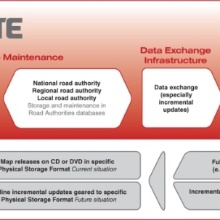Objectives:
The ROSATTE project aims to establish an efficient and quality ensured data supply chain from public authorities to commercial map providers with regards to safety related road content. Figure 1 shows the involved entities at the three levels of data acquisition, exchange and integration and the anticipated dataflow.

Coordinator:
ERTICO- ITS Europe, Belgien
Partners:
- Association des sociétés françaises d'autoroute (ASFA), Frankreich
- Laboratoire Régional de l'Ouest Parisien (LROP), Frankreich
- Vlaamse Overheid - Dept MOW (Flämische Verkehrsbehörde), Belgien
- NAVTEQ, Niederlande
- Norwegische Straßenverkehrsbehörde (NPRA)
- Oberste Bayrische Baubehörde im Staatsministerium des Innern (OBB)
- PTV AG, Karlsruhe, Deutschland
- Französisches Verkehrsministerium (SETRA)
- SINTEF, Norwegen
- Schwedische Verkehrsbehörde (STA)
- Tele Atlas, Niederlande
- TRIONA, Schweden
- Universität Stuttgart, Insitut für Ingenieurgeodäsie (IIGS)
- Transport for London (TfL), Großbritannien
Procedure:
Up-to-date safety attributes are needed by road authorities and for Advanced Driver Assistance Systems (ADAS). ADAS applications are commercial products that can contribute significantly to achieving objectives for reducing the yearly number of road fatalities on European roads by half in 2010. In this context, road signs like speed limits or other warning signs are considered road safety features. The information about these features is acquired, maintained and used by public road authorities within the EU member states for their internal duties. The idea of ROSATTE is now to make use of the information that anyway is available at the road authorities. Besides the exchange of full databases, special focus will be put on the exchange of new or changed data, so-called incremental updates.
The ROSATTE project intends to develop the enabling infrastructure and supporting tools that will ensure European access to road safety attributes including incremental updates. This infrastructure will facilitate administrative internal functions as well as supply of data to third parties e.g. for safety relevant services.
The IIGS mainly contributes to all project tasks related to data quality, i.e. quality management and validation of results.
Within this quality management concept, the IIGS developed and applied the test and validation methodology. With its help, the IIGS tested and validated all developed methods and tools within ROSATTE. The completeness, topological correctness and accuracy of the integrated features were of interest. It could be shown, that the developed data exchange infrastructure works with satisfying quality. However, the location referencing issue proved to be most critical and mainly influenced the integration completeness and correctness.
Publications:
- T’Siobbel, S., Reini, J., Schützle, R.: Integration of European Public Authorities Safety Attributes in Commercial Digital Maps Databases. Proceedings on the 15th ITS World Congress 2008, New York, United States, 16.-20.11.2008.
- Schützle, R.: Quality Management in ROSATTE. Proceedings on 16th ITS World Congress 2009, Stockholm, Sweden, 21.-25.09.2009.
- Schützle, R.: Quality Management for a Road Safety Feature Exchange Infrastructure. Proceedings on the 5th International Symposium "Networks for Mobility", Stuttgart, Germany 30.09.-01.10.2010.
Contact:

Volker Schwieger
Prof. Dr.-Ing. habil. Dr. h.c.Director of the Institute




